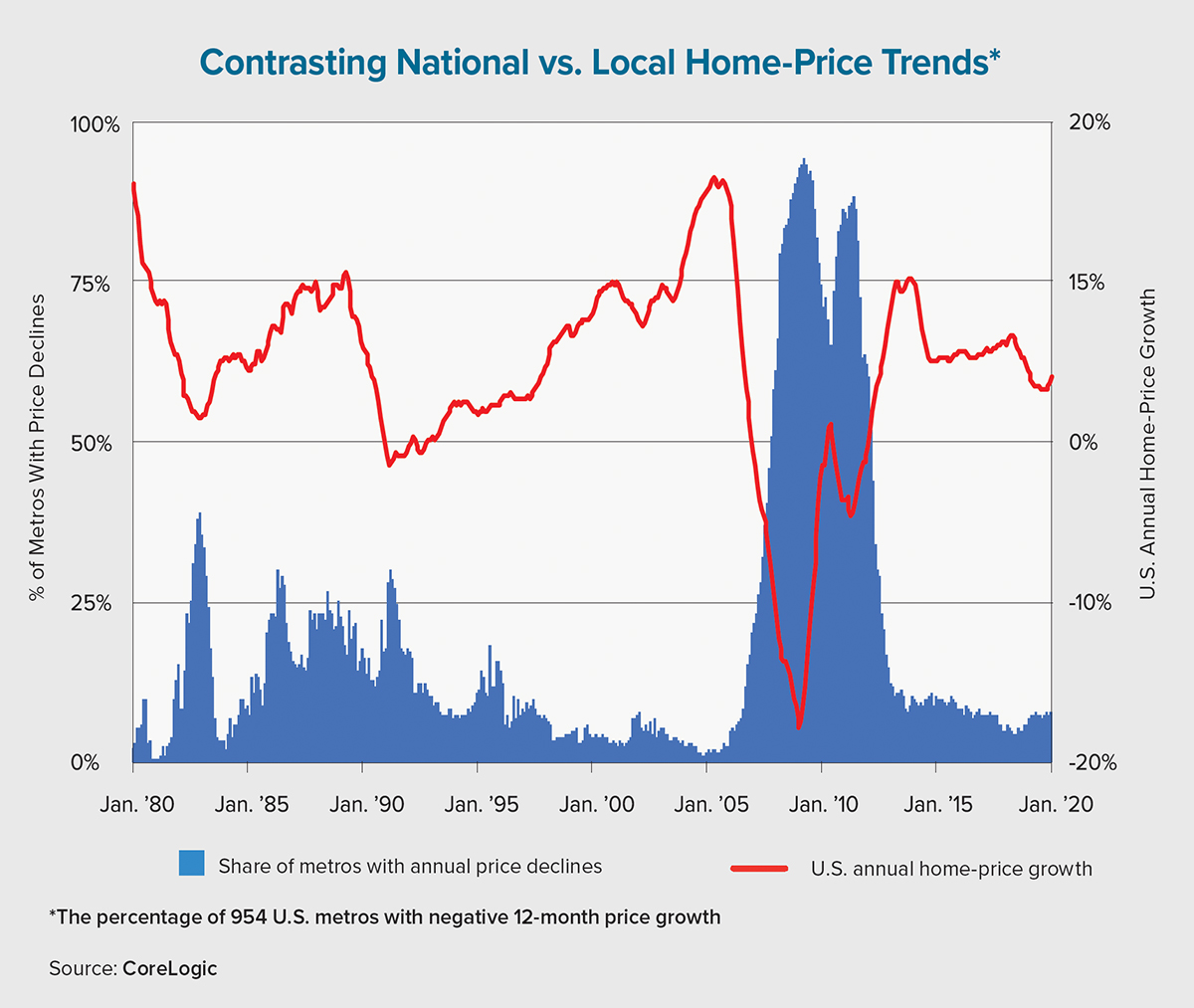Economists often use national data to convey broad trends in the U.S. housing market, but that can obscure divergent behavior in some locations. As an example, the national CoreLogic Home Price Index (HPI) increased more than 3% in 2019. And although prices have risen in most metro areas, the U.S. index masks the fact that many cities have had a dip in values over the past year and some will experience declines in 2020 as well.
Studying annual price changes across 954 U.S. metros — the core-based statistical areas defined by the Office of Management and Budget — over the past 40 years shows that the share of metros with a month-over-month price decline varied from 1% to 94%.
On average, 18% of these metros had price decreases in any given month from January 1980 through January 2020 and, as the chart on this page shows, there were always cities with price declines even when the national index rose. In 2019, the HPI charted more than 70 metros with annual home-price declines. These included New York City, San Jose and Bridgeport, Connecticut.
A severe price decline of 10% or more in a single year is uncommon, but it has occurred. As the Great Recession deepened, the HPI recorded annualized double-digit declines in both 2008 and 2009. The widespread severity of the downturn was felt across the nation with nearly one-third of all metros experiencing year-over-year price declines of at least 10%.
Severe localized price decreases can happen even when the national index is rising or flat, reflecting the gravity of a local economic depression. The crash in oil prices in the mid-1980s led to a collapse in home prices of more than 10% annually in Austin and Tulsa, Oklahoma, even though the U.S. index continued to rise. And the real estate boom in New England during the late 1980s was closely followed by the 1990-1991 national recession, which resulted in annualized home prices falling by double digits in the Boston and Hartford, Connecticut, metro areas. The U.S. index had a modest dip of 1% at that time.
Falling home prices have serious consequences for families, neighborhoods and mortgage lenders. A decline in values and an accompanying rise in unemployment often triggers mortgage delinquencies, potentially leading to foreclosures. The ability to monitor potential price declines can help lenders prepare loss-mitigation strategies. This is particularly important when capital markets are volatile and the economic environment has heightened uncertainty, as has occurred this year due to COVID-19.
CoreLogic’s Market Risk Indicators calculate the likelihood of a home-price decline and serve as a risk-management tool for mortgage lenders and servicers. These indicators provide probability estimates of a one-year decline and a severe one-year decline of 10% or more. They are updated on a monthly basis for 392 metro areas, as well as each state and the District of Columbia. Even before COVID-19, the indicators found that 2% to 3% of U.S. metros are likely to experience home-price declines this year.
So, even though a national price forecast is convenient shorthand, it can hide disparate performances in local markets. An industry best practice is to closely monitor home-price behavior at a local level.
Author
-

Frank E. Nothaft is chief economist for CoreLogic, America’s largest provider of advanced property and ownership information, analytics and data-enabled services. He leads the economics team responsible for analysis, commentary and forecasting trends in global real estate, insurance and mortgage markets. Before joining CoreLogic, Nothaft served as chief economist for Freddie Mac. Prior to Freddie Mac, he was an economist with the Board of Governors of the Federal Reserve System.





